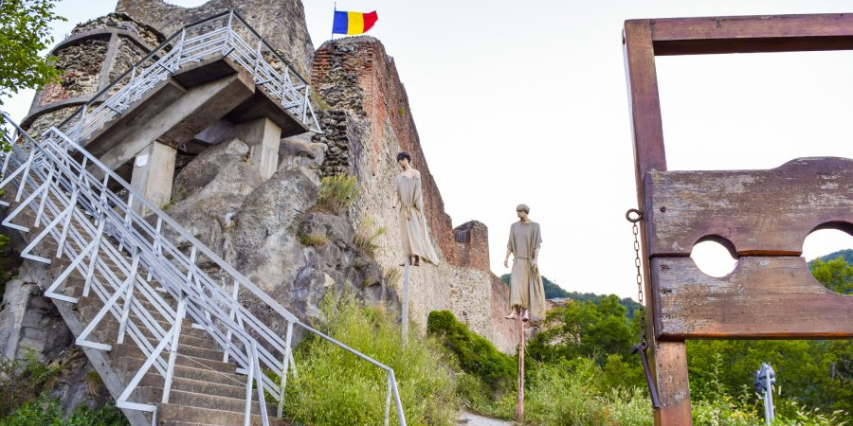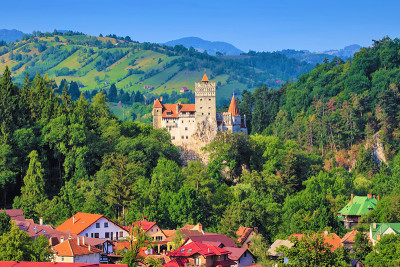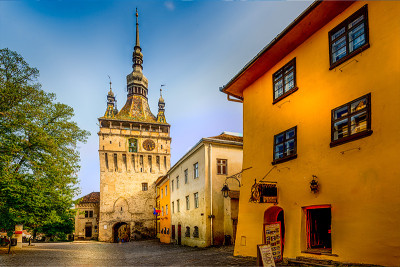Vlad the Impaler’s real name is Vlad III Dracula. Some believe that Irishman author Bram Stoker’s novel, Dracula, was based off the life of Vlad the Impaler. It is unknown for certain whether this was Stoker’s intention, but there are quite a few similarities between Count Dracula and Vlad.
According to the novel, however, Count Dracula lived on a castle that towered over an ominous hill somewhere dreary in Transylvania – Bran Castle is often advertised as “Dracula’s Castle” because it fits the description from Stoker’s novel, even though Stoker had never actually seen or heard of the castle in real life.
If you head out to Bran Castle, you can learn a little more about Vlad and Stoker’s story of Dracula. But don’t be fooled: Bran Castle was not Vlad III Dracula’s castle. Bran Castle is an impressive and beautiful building that is definitely worth a visit, but it was not where Vlad lived.
Vlad the Impaler’s castle was in near the small town of Arefu, not too far from Bran Castle. Bran Castle is located on the border of what was Wallachia and Transylvania. Vlad was ruler of Wallachia, and his castle was in Wallachia. Vlad’s castle was Poenari Castle. It is located in the middle of present-day Romania, about 100 miles northwest of Bucharest.
Poenari Castle sits on top of a cliff that overlooks the Arges River. It was originally home to the Basarab rulers. The Basarabs were an important royal Wallachian family. They helped found the Principality of Wallachia and gave the country its first line of Princes. It also happens that their blood line was closely related to that of the Musatin rulers of Moldavia.
When the Basarbs lived in the Castle, it was known as Castle Arges. After that, the castle changed named and hands several times and was eventually abandoned and left to deteriorate. The castle was essentially forgotten.
Vlad The Impaler Moves In
Legend has it, Vlad was hunting by the Arges River and happened upon the old Poenari Castle. It was in ruins, but it sat magnificently atop the cliff Mount Albina. The cliff was surrounded by the river, with the Castle having a magnificent view of the surroundings.
Vultures and other preying birds swarmed around, and there was not a person in sight. Vlad saw this Castle and was immediately captivated, dreaming up all the possibilities for his future inhabitance. What he imagined straightaway was using this Castle to build a defensive fortress, restoring the building to the glory it once had.
Vlad had all these grand plans for the Castle, but he had one problem: he needed money. As the story goes, in Romanian Fairy Tales and Legends written by E.B. Mawr, Vlad asked his boyars (boyars were the highest rank in aristocracy, just below the prince) for the money, and the refused.
Vlad condemned his men, and said to them:
“You would not give me the money I needed,” he said, “well, keep it! I will not have you killed to chastise you for your revolt, but I condemn you all, just as you are, to build with your own hands a Fortress on the top of Mount Albina.
I wish it to be the largest, the best built, and the most impregnable of all which I possess. You will not leave the mountain until all is finished. My soldiers, have the right of life and death over you, to force you to carry out my instructions.”
Like slaves, they were forced into labor. First, they built walking paths. Masons, stonecutters, carpenters, blacksmiths and other tradesmen were also commissioned for the job of restoring the castle. Men and women, and people of all ranks and ages – even children – were working on Vlad’s Castle. It is said that Mount Albina looked like an anthill, with a constant flow of tireless human traffic.
No matter what the weather was outside, everyone was to restore Poenari Castle without cease. Vlad would come by the Castle and inspect even the most minute of details, making sure that everything was done according to plan and according to his orders. When it was finally ready, Vlad moved in.
Although this paints a rather dark picture of Vlad the Impaler, he was still loved by many. Many of the people of the surrounding village of Arefu served Vlad personally. When Vlad’s Castle was attacked in 1462, the people offered him refuge, helping him escape from the Turks.
After Vlad’s Death
When Vlad died in 1476, the Castle continued to be in use for about the next 100 years. After that, however, the Castle was abandoned once again. It was left again to ruins and was in disrepair by the 17th century. The size and location of this Castle made it difficult for people to live in it. No one cared for the castle after it went into disrepair, and then on January 13, 1913 an earthquake struck.
It caused a landslide on Mount Albina and sent large parts of Poenari Castle crashing down in the Arges River. Two more earthquakes caused further damage, one in 1940 and a second in 1976. Since then, some repairs have been made to the walls and towers.
Visiting Poenari Castle
Since 2009, Poenari Castle has been administered by the Arges County Museum. Today, however, you cannot enter Poenari Castle. Bears roam the area and access is restricted. The tentative re-opening date of the Castle and Fortress is scheduled for 2022.
There are also plans in the owrks to build a tram car that brings tourists up to the Fortress, because currently tourists have to walk up 1,462 steps to get to the top — which is like walking up the Statute of Liberty four times!
So, for now, you cannot actually visit Poenari Castle, but you can put this one on your bucket list for future trips to Romania!

 ES
ES
 IT
IT
 DE
DE
 FR
FR


